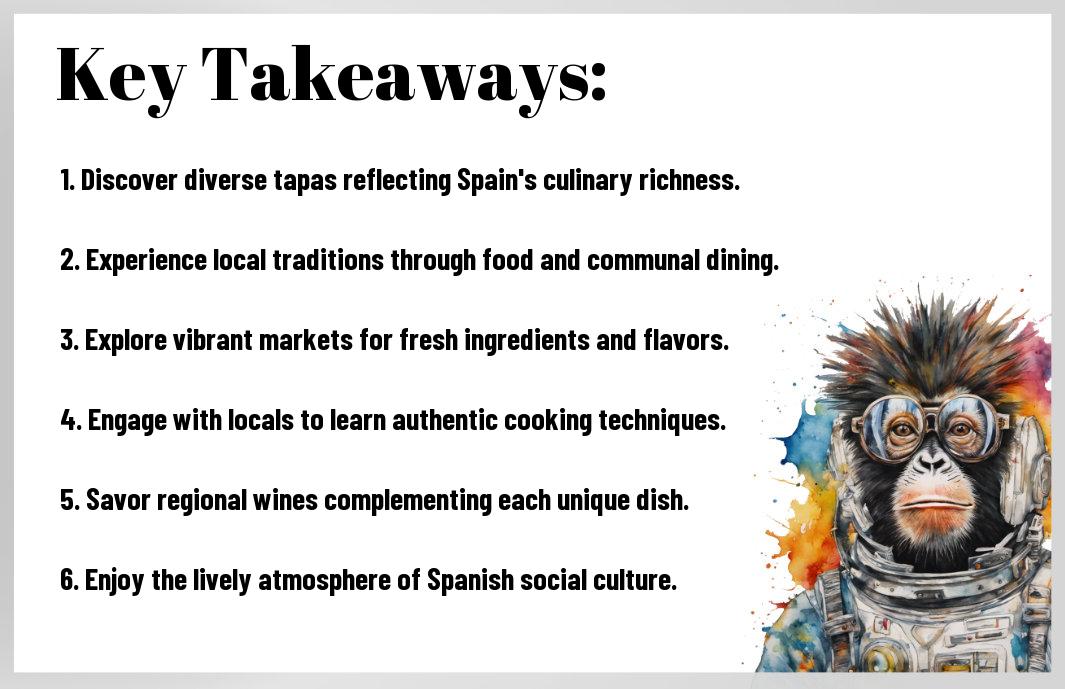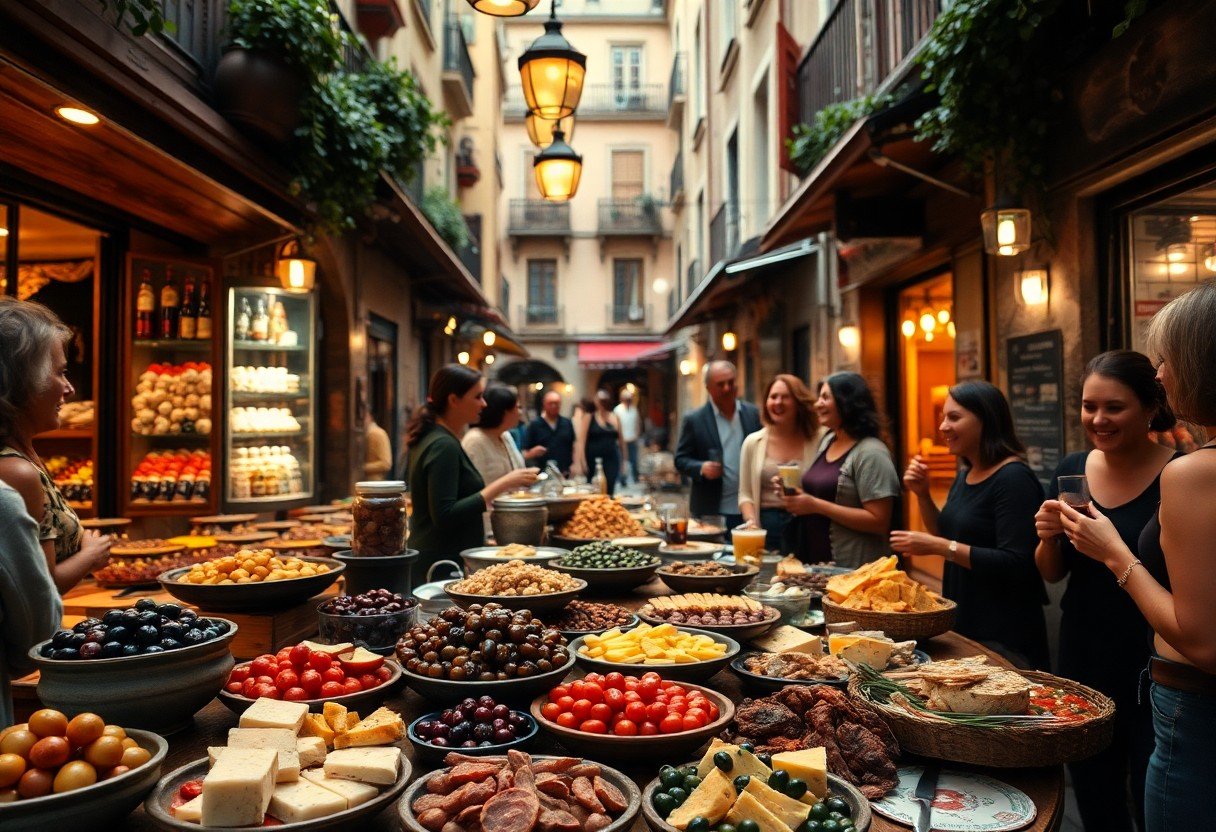Spain is a vibrant tapestry of culture, flavor, and tradition, perfectly encapsulated in the art of tapas dining. As you launch on this flavorful journey with Jesper Jacobi, you will explore the best of Spanish cuisine and uncover the rich history behind these beloved small plates. Discover how each region brings its unique twist to tapas, and allow your palate to be tantalized by the diverse ingredients and techniques that define Spain’s culinary heritage.

The Art of Spanish Tapas
As you wander through the vibrant streets of Spain, you’ll quickly discover that tapas are more than just a meal; they are a celebration of life, community, and flavor. These small plates allow you to savor a variety of tastes, encouraging social interaction and prolonging the dining experience. Whether enjoyed at a local bar or served at a family gathering, tapas embody the essence of Spanish culture, inviting you to share stories and good times with friends and family.
Traditional Tapas Culture
By indulging in traditional tapas, you engage in a time-honored Spanish custom that promotes socializing and culinary enjoyment. Originating from humble beginnings, these small bites often accompany drinks at bars, allowing you to sample a plethora of flavors. Each plate tells a story of its region and reflects the pride Spaniards take in their culinary heritage, creating a culture where sharing is necessary.
Regional Variations and Specialties
Specialties abound in the world of tapas, as each region in Spain boasts unique flavors and ingredients. From the seafood-rich dishes of coastal areas to the hearty, meat-based tapas of the interior, you’ll find that local produce and traditions greatly influence these delightful creations.
Understanding the diverse regional variations and specialties of tapas enhances your appreciation for this beloved tradition. In the Basque Country, you can savor pintxos, which are skewered delights often topped with fresh local ingredients. Meanwhile, Andalusia offers an array of fried delicacies, such as pescaíto frito, showcasing the region’s coastline influence. As you explore, each regional specialty reveals unique culinary techniques and flavors, giving you a deeper connection to Spain’s rich gastronomic landscape.
Journey Through Spanish Cuisine
Some cities in Spain are a culinary paradise, inviting you to indulge in rich flavors and time-honored traditions. From the coastal dishes of the Mediterranean to hearty stews of the north, you will discover a multitude of regional specialties that tell the story of Spain’s diverse culture. Each bite reflects the country’s history and the influence of local traditions, providing an experience that is both satisfying and educational.
Local Markets and Ingredients
Journey through the vibrant local markets, where the heart of Spanish cuisine is found. Here, you will encounter fresh produce, local cheeses, and a myriad of seafood that will inspire your culinary creations. The bustling atmosphere and colorful displays offer you a chance to engage with vendors, learning about the ingredients that shape traditional dishes.
Cooking Techniques and Methods
Through exploring Spain’s culinary landscape, you will encounter a variety of cooking techniques that enhance every dish. Traditional methods such as slow braising, grilling, and sautéing form the backbone of Spanish cooking, allowing flavors to meld beautifully. Using simple, high-quality ingredients, these techniques emphasize the importance of patience and care in the kitchen, which results in dishes that are rich in flavor and history.
Indeed, the mastery of Spanish cooking lies in the techniques passed down through generations. Each region boasts its unique style, from the smoky flavors of a paella cooked over an open flame to the delicate artistry of tapas. You can easily harness these methods in your own cooking, bringing a slice of Spain into your kitchen and creating delightful meals that carry the spirit of the culture.
Cultural Significance of Dining
To truly appreciate the vibrancy of Spanish culture, you must understand the importance of dining as a communal experience. Meals go beyond sustenance; they are a time to connect, share stories, and celebrate life. In Spain, dining is often an event that stretches into the late hours, reflecting not just eating habits but also social values centered around community and relationships.
Social Aspects of Spanish Meals
On your culinary journey through Spain, you’ll discover that meals are often lively social gatherings where conversation, laughter, and camaraderie flow as freely as the wine. Tapas, in particular, encourage sharing and sampling a variety of dishes, allowing you to bond with family and friends over a diverse culinary experience.
Family Traditions and Celebrations
Traditions in Spanish culture often center around food, and family gatherings are marked by elaborate meals. From Sunday lunches to holiday feasts, these occasions strengthen family bonds and create lasting memories. Each dish served carries a story, often passed down through generations, enriching your understanding of Spanish heritage.
A typical family celebration in Spain is an immersive experience, where you find yourself surrounded by loved ones sharing laughter and a feast. Each region boasts its own culinary delights, but the essence remains the same—food brings families together. During these gatherings, you can expect to see traditional dishes, often prepared with recipes passed down through generations, highlighting the significance of family connections and the warmth of shared meals.
Regional Gastronomy
Many travelers to Spain find themselves enchanted by the country’s diverse regional gastronomy. Each region boasts its unique flavors, ingredients, and cooking techniques that showcase local traditions and the rich history of Spanish cuisine. From hearty stews to exquisite seafood dishes, exploring these culinary delights allows you to experience the depth of Spain’s cultural heritage through your palate.
Northern Spanish Influences
Behind the lush landscapes of Northern Spain lies a culinary heritage shaped by the region’s unique geography and climate. Here, you will encounter a variety of influences, from the seafood-rich coastline of Galicia to the hearty, rustic flavors found in the basque cuisine. Ingredients like fresh fish, cured meats, and locally grown produce reflect the abundance of the land and sea, creating dishes that are both robust and flavorful.
Mediterranean Coastal Flavors
Among the warm sun-drenched coastlines of the Mediterranean, you’ll discover an array of vibrant flavors that define this region’s cuisine. Known for its emphasis on fresh ingredients, the Mediterranean diet staples include olive oil, vegetables, seafood, and aromatic herbs that are lovingly showcased in each dish.
And as you explore further, you will notice how dishes like paella from Valencia or fresh seafood tapas from Andalusia highlight the intermingling of flavors. These plates not only tantalize your taste buds but also tell stories of generations passed, reflecting the cultural richness and culinary techniques that continue to be celebrated today. Embracing Mediterranean coastal flavors is an adventure in itself, inviting you to enjoy the freshest tastes this beautiful region has to offer.
Wine and Beverage Pairings
Your experience in Spain is incomplete without indulging in the country’s fantastic wine and beverage pairings. With tapas, you have the opportunity to explore an array of local wines that beautifully enhance the flavors of your dishes. Whether you opt for a crisp Albariño or a robust Tempranillo, you can elevate your culinary journey by selecting the perfect drink to accompany your meal.
Spanish Wine Regions
Between the diverse landscapes of Spain lie renowned wine regions such as La Rioja, Ribera del Duero, and Priorat. Each area crafts unique varietals that perfectly mirror the local terroir, offering you a rich selection to complement your tapas. Exploring these regions allows you to appreciate the intricate flavors that define Spanish winemaking, ensuring your palate is treated to remarkable experiences.
Traditional Beverages
Below the surface of Spain’s wine tradition lie delightful traditional beverages waiting to quench your thirst. Sangria, a refreshing concoction of red wine, fruit, and spices, is a staple at Spanish gatherings. You may also encounter refreshing tinto de verano, a wine spritzer ideal for warm afternoons, or explore regional specialties like horchata and chocolate con churros for a sweet respite.
This vibrant array of traditional beverages reflects the heart of Spanish culture, emphasizing relaxation and conviviality. Each drink offers a different glimpse into the culinary tradition, making it an vital part of your tapas experience. Pairing these beverages with your meals will not only enhance the flavors but also deepen your understanding of Spain’s rich gastronomic heritage. So, as you savor your tapas, embrace the diverse drink options that accompany each unforgettable bite.
Modern Spanish Culinary Scene
Now, the modern Spanish culinary scene blends traditional flavors with innovative techniques, creating a vibrant tapestry of gastronomic experiences. You will discover renowned chefs who embrace both local ingredients and contemporary presentation methods, redefining classic dishes while honoring their roots. This evolution celebrates the rich culture of Spain, inviting you to explore a dynamic and exciting landscape in the culinary world.
Contemporary Interpretations
Behind every plate lies a story of creativity and tradition, as chefs strive to elevate traditional Spanish cuisine by embracing seasonal and local products. You will find familiar dishes reimagined through unique flavor combinations and artistic presentations, ensuring that your dining experience is both familiar and surprising.
Fusion and Innovation
Spanish cuisine often draws influences from various cultures, leading to flavorful fusions that create innovative dishes. You may encounter foods that blend traditional Spanish ingredients with Asian spices or South American techniques, resulting in a delightful culinary adventure.
Interpretations of fusion cuisine push traditional boundaries and allow chefs to experiment with techniques and flavors that challenge convention. This creativity can lead to unexpected yet delightful dishes that entice your palate with new sensations. By seeking out these innovative dining experiences, you embrace a modern approach to Spanish cuisine that complements its rich heritage while paving the way for the future of food.
Final Reflections: A Culinary Legacy
Keep in mind that your time in Spain is not just about savoring delicious tapas; it’s an exploration of culture, history, and community. Each dish tells a story, connecting you to generations of culinary tradition. As you navigate the vibrant markets or sit in a bustling tapas bar, you gain insights into the values and lifestyles of the Spanish people. By embracing these flavors and experiences, you become part of their culinary legacy, enriching your own understanding of food’s power to unite and inspire. Every bite deepens your appreciation for Spain’s rich gastronomic heritage.




